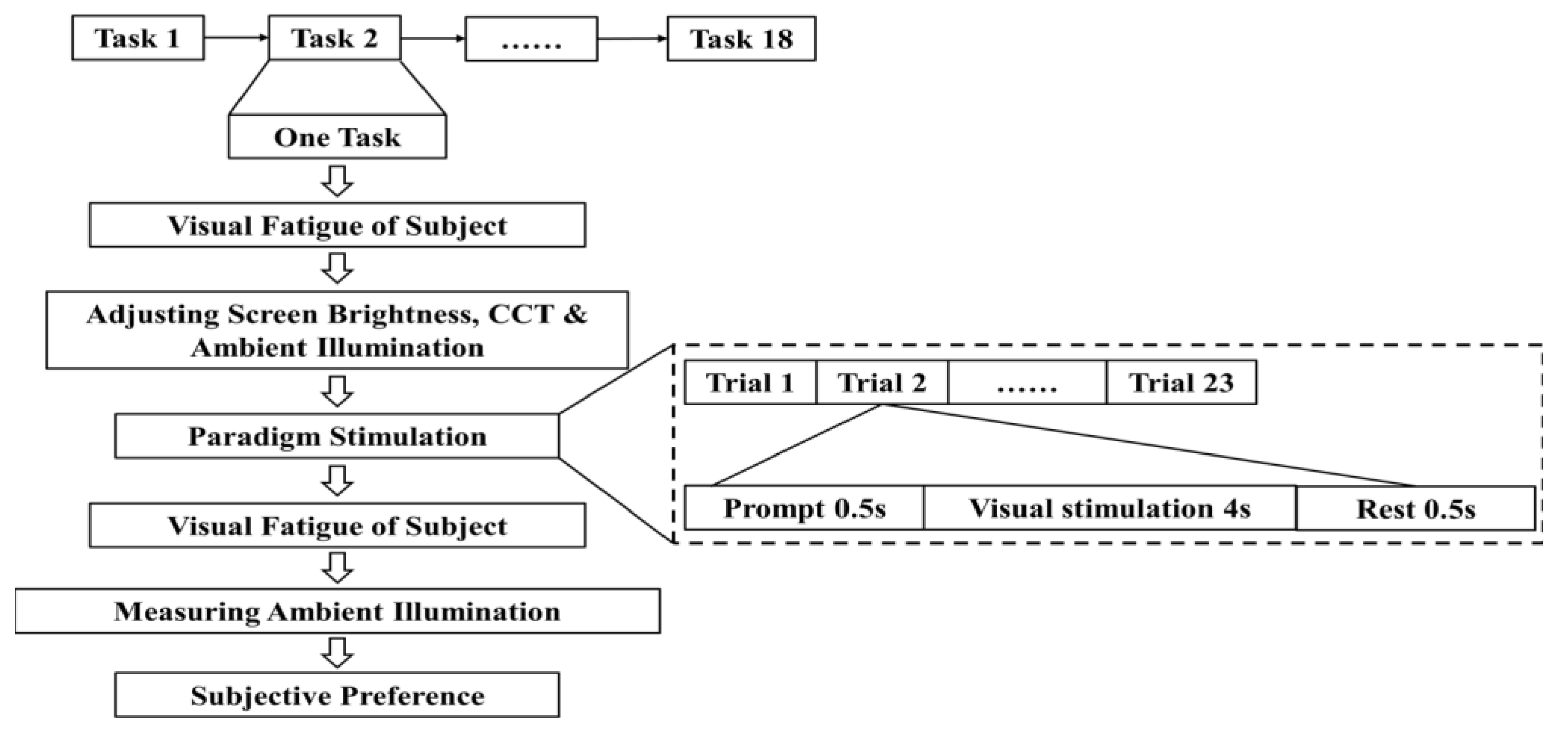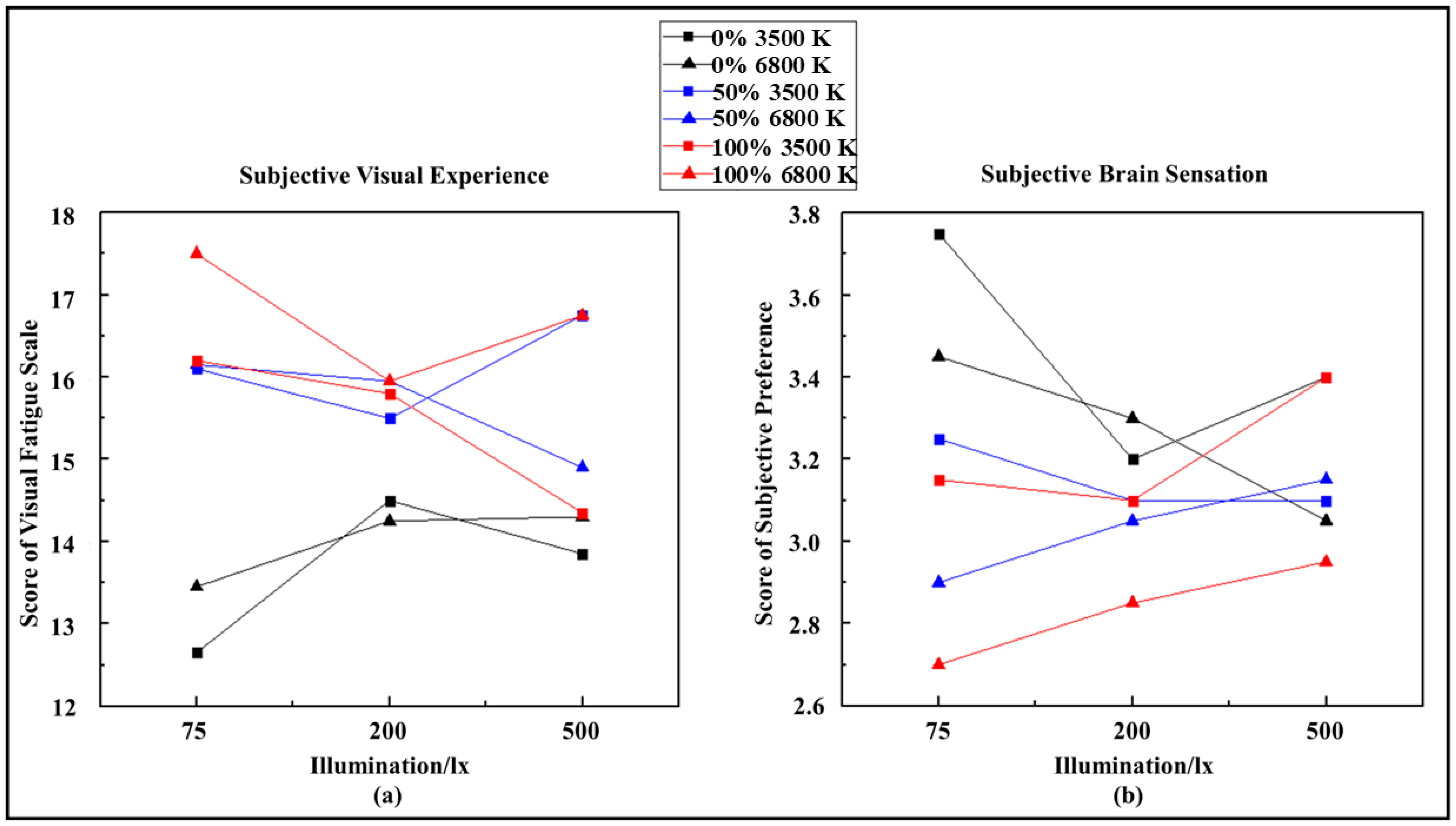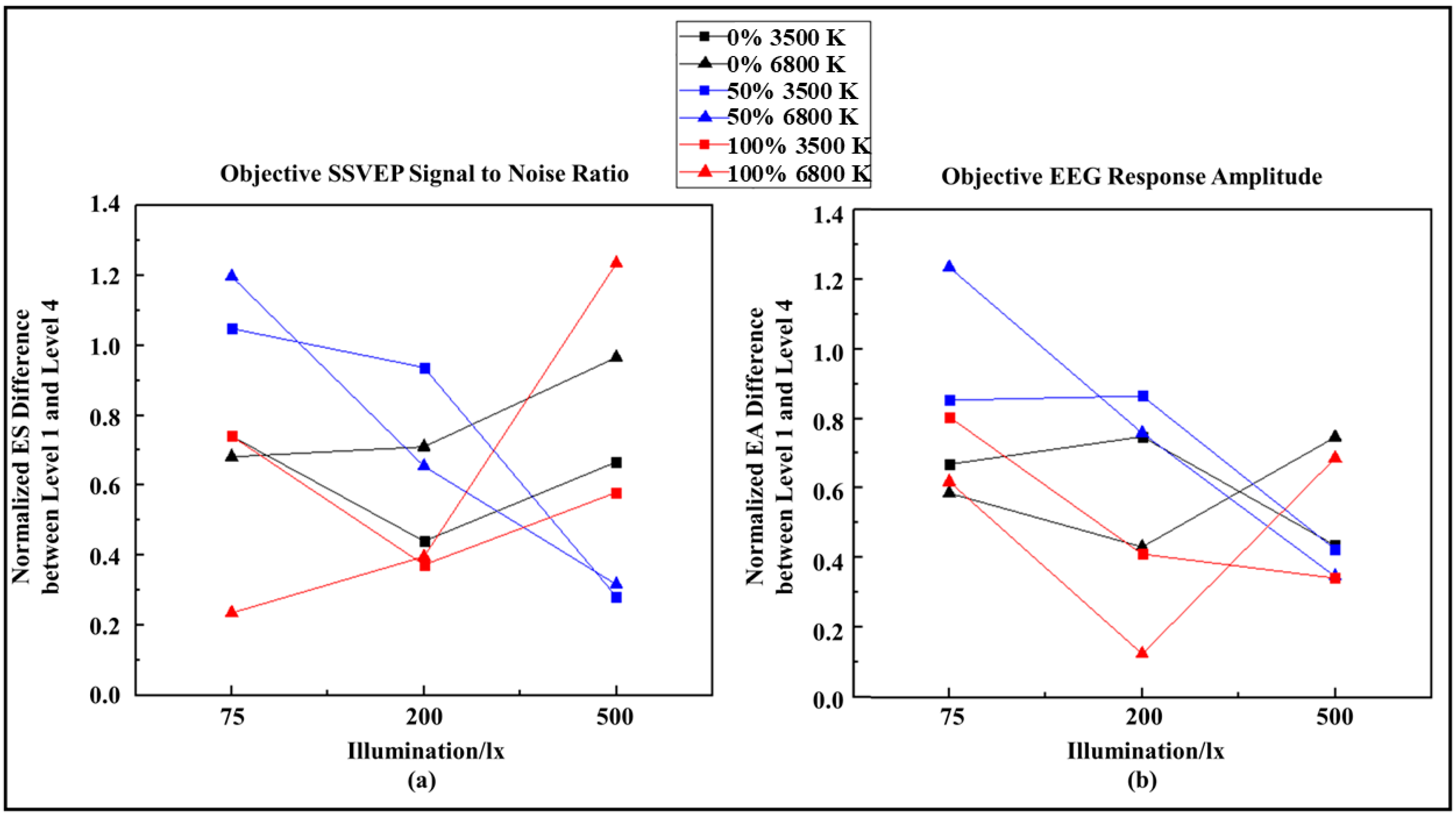Research on an Indoor Light Environment Comfort Evaluation Index Based on Electroencephalogram and Pupil Signals
Abstract
:1. Introduction
2. Materials and Methods
2.1. Experimental Chamber
2.2. Subjects
2.3. Data Acquisition
2.4. Stimulus Designs
2.5. Experimental Procedure
2.6. Experimental Index
2.6.1. Likert Scale of Subjective Visual Fatigue (SVF) and Subjective Preference (SP)
2.6.2. EEG Signal-to-Noise Ratio (ES) and EEG Amplitude (EA)
2.6.3. Pupil Diameter (PD)
2.7. Fatigue Quantitative Evaluation Model
- The data are divided into n groups according to the category. Categories are mainly distinguished by specific data source types. The subjective part is divided into pre-experiment and post-experiment. The objective part divides the first 1/4 into the least fatigued state and the last 1/4 into the most fatigued state according to the number of experiments.
- In the subjective part, the value of the post-experiment minus the value of the pre-experiment is the original subjective fatigue value. In the objective part, the difference between the least fatigued state and the most fatigued state is taken as the original objective fatigue value according to the specific type of data.
- The obtained objective data are standardized, and the ratio of the original objective fatigue value to the initial objective calibration value is the standardized objective fatigue value.
- Data are mapped forward or backward (according to the characteristics of the data) to the [0,1] interval;
- The CRITIC algorithm (Supplementary Materials) is used to calculate the corresponding weights of n sets of data: w1, w2, ..., wn;
- The obtained CRITIC weight is multiplied by the corresponding n sets of data quantization values and added to obtain the final fatigue quantization score.
2.8. Statistical Analysis
3. Results
3.1. Subjective Analysis
3.2. Objective Analysis
3.3. Light Environment Comfort Evaluation
3.3.1. CRITIC Weight
3.3.2. Visual Comfort Level
3.3.3. Reliability Demonstration
4. Discussion
4.1. Significance Analysis
4.2. Limitations of This Research
5. Conclusions
Supplementary Materials
Author Contributions
Funding
Institutional Review Board Statement
Informed Consent Statement
Data Availability Statement
Acknowledgments
Conflicts of Interest
References
- Dong, X.; Wu, Y.Y.; Chen, X.D.; Li, H.; Cao, B.; Zhang, X.; Yan, X.; Li, Z.X.; Long, Y.B.; Li, X.T. Effect of thermal, acoustic, and lighting environment in underground space on human comfort and work efficiency: A review. Sci. Total Environ. 2021, 786, 147537. [Google Scholar] [CrossRef]
- Wang, K.; Ho, C.H.; Zong, Y. Analysis of Brightness and Color Temperature of Liquid Crystal Display on Visual Comfort Based on Eye Health Monitoring of Humans. J. Med. Imag. Health 2020, 10, 1359–1364. [Google Scholar] [CrossRef]
- Hu, S.T.; He, M.Y.; Liu, G.D.; Lu, M.L.; Liang, P.; Liu, F. Correlation between the visual evoked potential and subjective perception at different illumination levels based on entropy analysis. Build. Environ. 2021, 194, 107715. [Google Scholar] [CrossRef]
- Ward Thompson, C.; Aspinall, P.A. Natural environments and their impact on activity, health, and quality of life. Appl. Psychol. Health Well Being 2011, 3, 230–260. [Google Scholar] [CrossRef]
- Hu, S.T.; Lu, M.L.; He, M.Y.; Wang, G.; Liang, P.; Tong, L.; Liu, G.D. Research on the light comfort characterization method based on visual evoked potential energy. Build. Environ. 2021, 197, 107831. [Google Scholar] [CrossRef]
- Wang, C.; Zhang, F.; Wang, J.L.; Doyle, J.K.; Hancock, P.A.; Mak, C.M.; Liu, S.C. How indoor environmental quality affects occupants ? cognitive functions: A systematic review. Build. Environ. 2021, 193, 107647. [Google Scholar] [CrossRef]
- Gupta, P.K.; Muhuri, P.K. Perceptual computing based performance control mechanism for power efficiency in mobile embedded systems. In Proceedings of the 2014 IEEE International Conference on Fuzzy Systems (FUZZ-IEEE), Beijing, China, 6–11 July 2014; pp. 1654–1661. [Google Scholar]
- Torresin, S.; Pernigotto, G.; Cappelletti, F.; Gasparella, A. Combined effects of environmental factors on human perception and objective performance: A review of experimental laboratory works. Indoor Air 2018, 28, 525–538. [Google Scholar] [CrossRef]
- GB50034-2013; Architectural Lighting Design Standard. China Architecture & Building Press: Beijing, China, 2013.
- Manav, B. An experimental study on the appraisal of the visual environment at offices in relation to colour temperature and illuminance. Build. Environ. 2007, 42, 979–983. [Google Scholar] [CrossRef]
- Gou, Z.H.; Lau, S.S.Y.; Ye, H. Visual alliesthesia: The gap between comfortable and stimulating illuminance settings. Build. Environ. 2014, 82, 42–49. [Google Scholar] [CrossRef]
- Leccese, F.; Salvadori, G.; Rocca, M.; Buratti, C.; Belloni, E. A method to assess lighting quality in educational rooms using analytic hierarchy process. Build. Environ. 2020, 168, 106501. [Google Scholar] [CrossRef]
- Fakhari, M.; Vahabi, V.; Fayaz, R. A study on the factors simultaneously affecting visual comfort in classrooms: A structural equation modeling approach. Energ. Build. 2021, 249, 111232. [Google Scholar] [CrossRef]
- Li, Y.; Ru, T.; Chen, Q.; Qian, L.; Luo, X.; Zhou, G. Effects of illuminance and correlated color temperature of indoor light on emotion perception. Sci. Rep. 2021, 11, 14351. [Google Scholar] [CrossRef] [PubMed]
- Xie, X.J.; Song, F.H.; Liu, Y.; Wang, S.R.; Yu, D. Study on the Effects of Display Color Mode and Luminance Contrast on Visual Fatigue. IEEE Access 2021, 9, 35915–35923. [Google Scholar] [CrossRef]
- Tian, P.Y.; Xu, G.H.; Han, C.C.; Zheng, X.W.; Zhang, K.; Du, C.H.; Wei, F.; Zhang, S.C. Effects of Paradigm Color and Screen Brightness on Visual Fatigue in Light Environment of Night Based on Eye Tracker and EEG Acquisition Equipment. Sensors 2022, 22, 4082. [Google Scholar] [CrossRef]
- Zeng, S.; Hao, W.; Guo, Y.; Wang, Y.; Fu, J.; Wang, G.; Cai, J. Ocular physiological responses to dynamic and constant screen brightness. In Proceedings of the 2021 18th China International Forum on Solid State Lighting & 2021 7th International Forum on Wide Bandgap Semiconductors (SSLChina: IFWS), Shenzhen, China, 6–8 December 2021; pp. 158–161. [Google Scholar]
- Lu, M.L.; Hu, S.T.; Mao, Z.; Liang, P.; Xin, S.; Guan, H.Y. Research on work efficiency and light comfort based on EEG evaluation method. Build. Environ. 2020, 183, 107122. [Google Scholar] [CrossRef]
- Dillon, T.W.; Emurian, H.H. Some factors affecting reports of visual fatigue resulting from use of a VDU. Comput. Hum. Behav. 1996, 12, 49–59. [Google Scholar] [CrossRef]
- Lee, H.J.; Kim, S.J. Factors Associated with Visual Fatigue from Curved Monitor Use: A Prospective Study of Healthy Subjects. PLoS ONE 2016, 11, e0164022. [Google Scholar] [CrossRef]
- Kim, Y.-J.; Lee, E.C. EEG based comparative measurement of visual fatigue caused by 2D and 3D displays. In Proceedings of the International Conference on Human-Computer Interaction, Orlando, FL, USA, 9–14 July 2011; pp. 289–292. [Google Scholar]
- Ukai, K.; Kato, Y. The use of video refraction to measure the dynamic properties of the near triad in observers of a 3-D display. Ophthalmic Physiol. Opt. 2002, 22, 385–388. [Google Scholar] [CrossRef]
- Ukai, K.; Howarth, P.A. Visual fatigue caused by viewing stereoscopic motion images: Background, theories, and observations. Displays 2008, 29, 106–116. [Google Scholar] [CrossRef]
- de Zeeuw, J.; Papakonstantinou, A.; Nowozin, C.; Stotz, S.; Zaleska, M.; Hädel, S.; Bes, F.; Münch, M.; Kunz, D. Living in biological darkness: Objective sleepiness and the pupillary light responses are affected by different metameric lighting conditions during daytime. J. Biol. Rhythm. 2019, 34, 410–431. [Google Scholar] [CrossRef]
- Sun, C.; Lian, Z.; Lan, L. Work performance in relation to lighting environment in office buildings. Indoor Built Environ. 2019, 28, 1064–1082. [Google Scholar] [CrossRef]
- Lambooij, M.; IJsselsteijn, W.; Fortuin, M.; Heynderickx, I. Visual discomfort and visual fatigue of stereoscopic displays: A review. J. Imaging Sci. Technol. 2009, 53, 30201. [Google Scholar] [CrossRef]
- Sheedy, J.E.; Hayes, J.; Engle, J. Is all asthenopia the same? Optom. Vis. Sci. 2003, 80, 732–739. [Google Scholar] [CrossRef]
- Birbaumer, N. Breaking the silence: Brain–computer interfaces (BCI) for communication and motor control. Psychophysiology 2006, 43, 517–532. [Google Scholar] [CrossRef]
- Voznenko, T.I.; Chepin, E.V.; Urvanov, G.A. The Control System Based on Extended BCI for a Robotic Wheelchair. Procedia Comput. Sci. 2018, 123, 522–527. [Google Scholar] [CrossRef]
- Tariq, M.; Trivailo, P.M.; Simic, M. EEG-Based BCI Control Schemes for Lower-Limb Assistive-Robots. Front. Hum. Neurosci. 2018, 12, 312. [Google Scholar] [CrossRef] [PubMed]
- Veena, N.; Anitha, N. A review of non-invasive BCI devices. Int. J. Biomed. Eng. Technol. 2020, 34, 205–233. [Google Scholar]
- Mehdizavareh, M.H.; Hemati, S.; Soltanian-Zadeh, H. Enhancing performance of subject-specific models via subject-independent information for SSVEP-based BCIs. PLoS ONE 2020, 15, e0226048. [Google Scholar] [CrossRef] [PubMed]
- Society, A.C.N. Guideline 5: Guidelines for standard electrode position nomenclature. Am. J. Electroneurodiagn. Technol. 2006, 46, 222–225. [Google Scholar]
- Almoqbel, F.M.; Yadav, N.K.; Leat, S.J.; Head, L.M.; Irving, E.L. Effects of sweep VEP parameters on visual acuity and contrast thresholds in children and adults. Graefes Arch. Clin. Exp. Ophthalmol. 2011, 249, 613–623. [Google Scholar] [CrossRef]
- Ng, K.B.; Bradley, A.P.; Cunnington, R. Stimulus specificity of a steady-state visual-evoked potential-based brain–computer interface. J. Neural Eng. 2012, 9, 036008. [Google Scholar] [CrossRef]
- Chen, Y.C.; Yeh, S.L. Catch the moment: Multisensory enhancement of rapid visual events by sound. Exp. Brain Res. 2009, 198, 209–219. [Google Scholar] [CrossRef]
- Owens, M.; Koster, E.H.W.; Derakshan, N. Improving attention control in dysphoria through cognitive training: Transfer effects on working memory capacity and filtering efficiency. Psychophysiology 2013, 50, 297–307. [Google Scholar] [CrossRef] [PubMed]
- Xie, J.; Xu, G.H.; Wang, J.; Li, M.; Han, C.C.; Jia, Y.G. Effects of Mental Load and Fatigue on Steady-State Evoked Potential Based Brain Computer Interface Tasks: A Comparison of Periodic Flickering and Motion-Reversal Based Visual Attention. PLoS ONE 2016, 11, e0163426. [Google Scholar] [CrossRef]
- Zheng, X.W.; Xu, G.H.; Zhang, Y.B.; Liang, R.H.; Zhang, K.; Du, Y.H.; Xie, J.; Zhang, S.C. Anti-fatigue Performance in SSVEP-Based Visual Acuity Assessment: A Comparison of Six Stimulus Paradigms. Front. Human. Neurosci. 2020, 14, 301. [Google Scholar] [CrossRef]
- Lin, Z.L.; Zhang, C.S.; Wu, W.; Gao, X.R. Frequency recognition based on canonical correlation analysis for SSVEP-based BCIs. IEEE Trans. Biomed. Eng. 2006, 53, 2610–2614. [Google Scholar] [CrossRef] [PubMed]
- Kalunga, E.; Djouani, K.; Hamam, Y.; Chevallier, S.; Monacelli, E. SSVEP enhancement based on Canonical Correlation Analysis to improve BCI performances. In Proceedings of the 2013 Africon IEEE, Pointe aux Piments, Mauritius, 9–12 September 2013; pp. 1–5. [Google Scholar]
- Bin, G.; Gao, X.; Yan, Z.; Hong, B.; Gao, S. An online multi-channel SSVEP-based brain–computer interface using a canonical correlation analysis method. J. Neural Eng. 2009, 6, 046002. [Google Scholar] [CrossRef]
- Nakanishi, M.; Wang, Y.; Wang, Y.T.; Jung, T.P. A Comparison Study of Canonical Correlation Analysis Based Methods for Detecting Steady-State Visual Evoked Potentials. PLoS ONE 2015, 10, e0140703. [Google Scholar] [CrossRef]
- Kim, T.; Lee, E.C. Experimental Verification of Objective Visual Fatigue Measurement Based on Accurate Pupil Detection of Infrared Eye Image and Multi-Feature Analysis. Sensors 2020, 20, 4814. [Google Scholar] [CrossRef]
- Hayes, J.R.; Sheedy, J.E.; Stelmack, J.A.; Heaney, C.A. Computer use, symptoms, and quality of life. Optom. Vis. Sci. 2007, 84, E738–E755. [Google Scholar] [CrossRef] [PubMed]
- Benedetto, S.; Drai-Zerbib, V.; Pedrotti, M.; Tissier, G.; Baccino, T. E-readers and visual fatigue. PLoS ONE 2013, 8, e83676. [Google Scholar] [CrossRef] [PubMed]
- Makri, D.; Farmaki, C.; Sakkalis, V. Visual fatigue effects on steady state visual evoked potential-based brain computer interfaces. In Proceedings of the 2015 7th International IEEE/EMBS Conference on Neural Engineering (NER), Montpellier, France, 22–24 April 2015; pp. 70–73. [Google Scholar]
- Seo, S.-P.; Lee, M.-H.; Williamson, J.; Lee, S.-W. Changes in fatigue and EEG amplitude during a longtime use of brain-computer interface. In Proceedings of the 2019 7th International Winter Conference on Brain-Computer Interface (BCI), Gangwon, Republic of Korea, 18–20 February 2019; pp. 1–3. [Google Scholar]
- Peng, Y.; Wong, C.M.; Wang, Z.; Wan, F.; Vai, M.I.; Mak, P.U.; Hu, Y.; Rosa, A.C. Fatigue evaluation using multi-scale entropy of EEG in SSVEP-based BCI. IEEE Access 2019, 7, 108200–108210. [Google Scholar] [CrossRef]
- Chai, X.; Zhang, Z.; Guan, K.; Zhang, T.; Xu, J.; Niu, H. Effects of fatigue on steady state motion visual evoked potentials: Optimised stimulus parameters for a zoom motion-based brain-computer interface. Comput. Methods Programs Biomed. 2020, 196, 105650. [Google Scholar] [CrossRef] [PubMed]
- Peng, Y.; Wong, C.M.; Wang, Z.; Rosa, A.C.; Wang, H.T.; Wan, F. Fatigue detection in SSVEP-BCIs based on wavelet entropy of EEG. IEEE Access 2021, 9, 114905–114913. [Google Scholar] [CrossRef]
- Guo, F.; Liu, L.; Li, M.; Greene, R.L. The effect of arm support and control modes on muscle fatigue, eye fatigue, and posture changes in mobile game use among young adults. Human. Factors Ergon. Manuf. Serv. Ind. 2021, 31, 496–505. [Google Scholar] [CrossRef]
- Fang, Y.; Liu, C.; Zhao, C.; Zhang, H.; Wang, W.; Zou, N. A study of the effects of different indoor lighting environments on computer work fatigue. Int. J. Environ. Res. Public Health 2022, 19, 6866. [Google Scholar] [CrossRef] [PubMed]
- Tian, P.; Xu, G.; Han, C.; Zhang, X.; Zheng, X.; Wei, F.; Zhang, S.; Zhao, Z. A quantization algorithm of visual fatigue based on underdamped second order stochastic resonance for steady state visual evoked potentials. Front. Neurosci. 2023, 17, 1278652. [Google Scholar] [CrossRef]
- Osterhaus, W.; Hemphälä, H.; Nylén, P.J.W. Lighting at computer workstations. Work 2015, 52, 315–328. [Google Scholar] [CrossRef]
- Guterman, P.S.; Fukuda, K.; Wilcox, L.M.; Allison, R.S. 75.3: Is brighter always better? The effects of display and ambient luminance on preferences for digital signage. SID Symp. Dig. Tech. Pap. 2010, 41, 1116–1119. [Google Scholar] [CrossRef]
- Lan, L. Mechanism and evaluation of the effects of indoor environmental quality on human productivity. Ph.D. Thesis, Shanghai Jiao Tong University, Shanghai, China, 2010. [Google Scholar]
- Hartstein, L.E.; Tuzikas, A.; Karlicek, R.F., Jr. The impact of dynamic changes in light spectral power distribution on cognitive performance and wellbeing. LEUKOS 2020, 16, 289–301. [Google Scholar] [CrossRef]
- Pei, Z.F.; Lin, B.R.; Liu, Y.C.; Zhu, Y.X. Comparative study on the indoor environment quality of green office buildings in China with a long-term field measurement and investigation. Build. Environ. 2015, 84, 80–88. [Google Scholar] [CrossRef]
- Cao, C. Research on innovative application of artistic characteristics of building decoration materials in interior design based on big data. J. Phys. Conf. Ser. 2020, 1744, 022020. [Google Scholar] [CrossRef]
- Kang, J.; Chen, H.; Li, X.; Li, X. EEG entropy analysis in autistic children. J. Clin. Neurosci. 2019, 62, 199–206. [Google Scholar] [CrossRef] [PubMed]
- Xie, Y.; Oniga, S. A Review of Processing Methods and Classification Algorithm for EEG Signal. Carpathian J. Electron. Comput. Eng. 2020, 13, 23–29. [Google Scholar] [CrossRef]










| Condition Number | Illuminance/lx | Correlated Color Temperature/K | Screen Brightness/% |
|---|---|---|---|
| 1 | 75 | 6800 | 0 |
| 2 | 200 | ||
| 3 | 500 | ||
| 4 | 75 | 3500 | |
| 5 | 200 | ||
| 6 | 500 | ||
| 7 | 75 | 6800 | 50 |
| 8 | 200 | ||
| 9 | 500 | ||
| 10 | 75 | 3500 | |
| 11 | 200 | ||
| 12 | 500 | ||
| 13 | 75 | 6800 | 100 |
| 14 | 200 | ||
| 15 | 500 | ||
| 16 | 75 | 3500 | |
| 17 | 200 | ||
| 18 | 500 |
| Authors | Year of Publication | Visual Fatigue Assessment Method |
|---|---|---|
| Hayes et al. [45] | 2007 | Subjective questionnaire |
| Benedetto et al. [53] | 2013 | Subjective questionnaire + Critical Flicker Frequency (related to sensory perception function) + Eye blink |
| Makri et al. [49] | 2015 | SSVEP |
| Seo et al. [50] | 2019 | Subjective questionnaire + SSVEP |
| Peng et al. [51] | 2019 | Subjective questionnaire + SSVEP |
| Chai et al. [52] | 2020 | SSVEP |
| Peng et al. [18] | 2021 | Subjective questionnaire + SSVEP |
| Guo et al. [54] | 2021 | Subjective questionnaire |
| Tian et al. [16] | 2022 | Subjective questionnaire + SSVEP + Pupil diameter + Fusion indicators (weights given based on experience) |
| Ours | Subjective questionnaire + SSVEP + Pupil diameter + Fusion indicators (CRITIC weighting method, no personal experience required) |
Disclaimer/Publisher’s Note: The statements, opinions and data contained in all publications are solely those of the individual author(s) and contributor(s) and not of MDPI and/or the editor(s). MDPI and/or the editor(s) disclaim responsibility for any injury to people or property resulting from any ideas, methods, instructions or products referred to in the content. |
© 2024 by the authors. Licensee MDPI, Basel, Switzerland. This article is an open access article distributed under the terms and conditions of the Creative Commons Attribution (CC BY) license (https://creativecommons.org/licenses/by/4.0/).
Share and Cite
Tian, P.; Xu, G.; Han, C.; Zheng, X.; Zhang, K.; Du, C.; Zhang, X.; Wei, F.; Ma, Y.; Zhang, S.; et al. Research on an Indoor Light Environment Comfort Evaluation Index Based on Electroencephalogram and Pupil Signals. Electronics 2024, 13, 3411. https://doi.org/10.3390/electronics13173411
Tian P, Xu G, Han C, Zheng X, Zhang K, Du C, Zhang X, Wei F, Ma Y, Zhang S, et al. Research on an Indoor Light Environment Comfort Evaluation Index Based on Electroencephalogram and Pupil Signals. Electronics. 2024; 13(17):3411. https://doi.org/10.3390/electronics13173411
Chicago/Turabian StyleTian, Peiyuan, Guanghua Xu, Chengcheng Han, Xiaowei Zheng, Kai Zhang, Chenghang Du, Xun Zhang, Fan Wei, Yunhao Ma, Sicong Zhang, and et al. 2024. "Research on an Indoor Light Environment Comfort Evaluation Index Based on Electroencephalogram and Pupil Signals" Electronics 13, no. 17: 3411. https://doi.org/10.3390/electronics13173411






